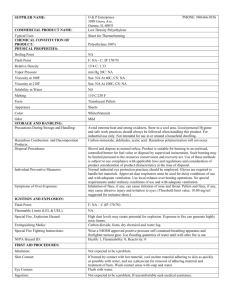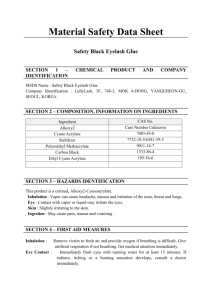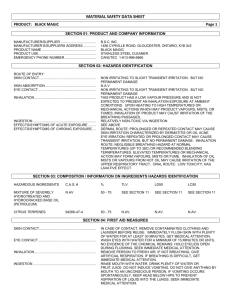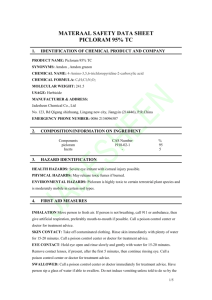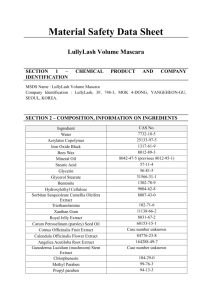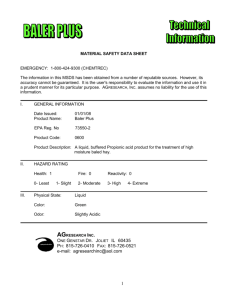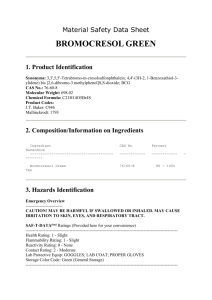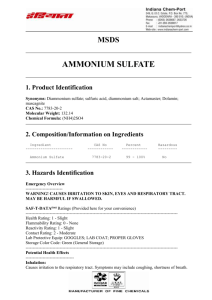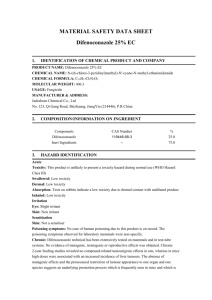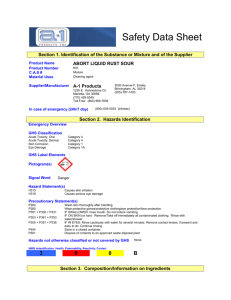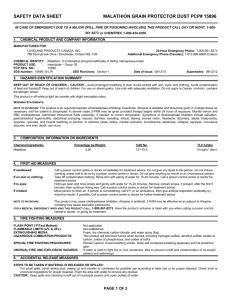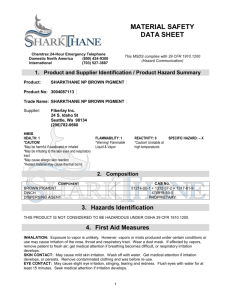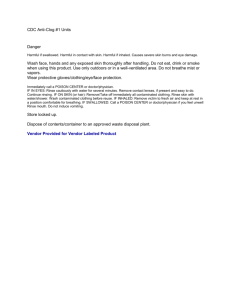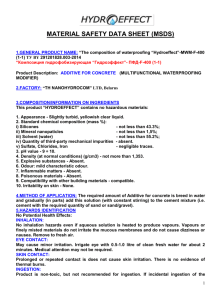Superior `70` Oil msds
advertisement
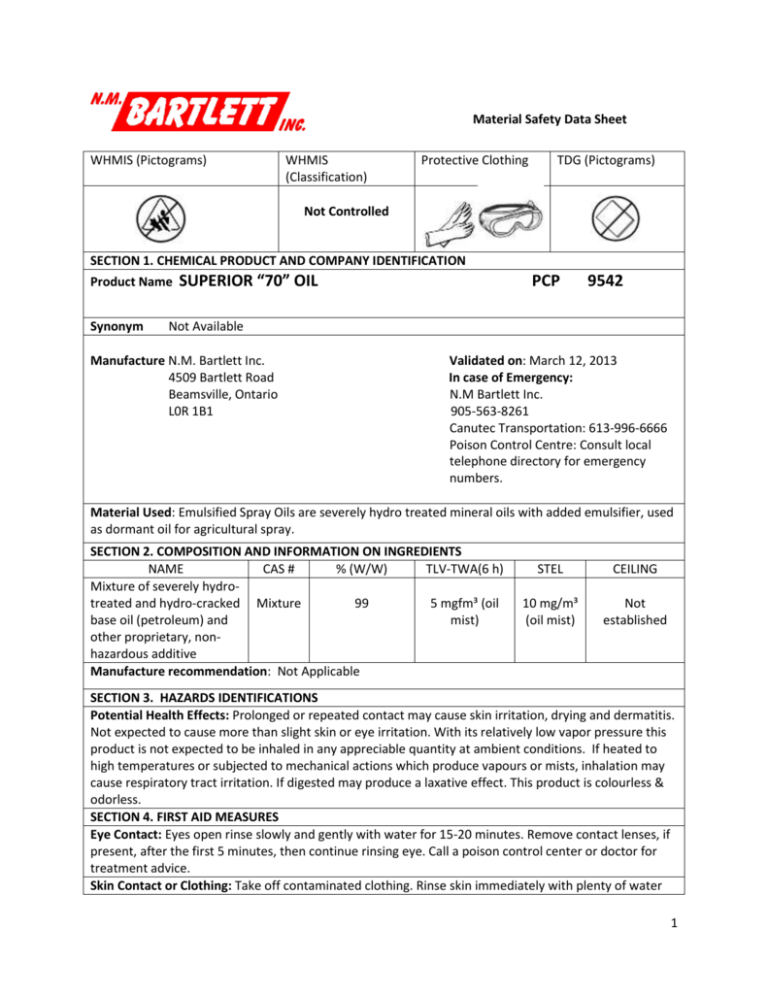
Material Safety Data Sheet WHMIS (Pictograms) WHMIS (Classification) Protective Clothing TDG (Pictograms) Not Controlled SECTION 1. CHEMICAL PRODUCT AND COMPANY IDENTIFICATION Product Name Synonym SUPERIOR “70” OIL PCP 9542 Not Available Manufacture N.M. Bartlett Inc. 4509 Bartlett Road Beamsville, Ontario L0R 1B1 Validated on: March 12, 2013 In case of Emergency: N.M Bartlett Inc. 905-563-8261 Canutec Transportation: 613-996-6666 Poison Control Centre: Consult local telephone directory for emergency numbers. Material Used: Emulsified Spray Oils are severely hydro treated mineral oils with added emulsifier, used as dormant oil for agricultural spray. SECTION 2. COMPOSITION AND INFORMATION ON INGREDIENTS NAME CAS # % (W/W) TLV-TWA(6 h) Mixture of severely hydrotreated and hydro-cracked Mixture 99 5 mgfm³ (oil base oil (petroleum) and mist) other proprietary, nonhazardous additive Manufacture recommendation: Not Applicable STEL CEILING 10 mg/m³ (oil mist) Not established SECTION 3. HAZARDS IDENTIFICATIONS Potential Health Effects: Prolonged or repeated contact may cause skin irritation, drying and dermatitis. Not expected to cause more than slight skin or eye irritation. With its relatively low vapor pressure this product is not expected to be inhaled in any appreciable quantity at ambient conditions. If heated to high temperatures or subjected to mechanical actions which produce vapours or mists, inhalation may cause respiratory tract irritation. If digested may produce a laxative effect. This product is colourless & odorless. SECTION 4. FIRST AID MEASURES Eye Contact: Eyes open rinse slowly and gently with water for 15-20 minutes. Remove contact lenses, if present, after the first 5 minutes, then continue rinsing eye. Call a poison control center or doctor for treatment advice. Skin Contact or Clothing: Take off contaminated clothing. Rinse skin immediately with plenty of water 1 for 15-20 minutes. Call a poison control center or doctor for further treatment advice. Inhalation: Gently move person to fresh air. If person is not breathing call 9 1 1 or an ambulance, then give artificial respiration preferably by mouth to mouth, if possible. Call a poison control center or doctor for further treatment advice. Swallowed: Don’t induce vomiting unless told to do so by a poison control center or doctor. Don’t give ANY liquid to that person. Don’t give anything by mouth to an unconscious person. Seek medical attention. Note to Physician: Contains Emulsified oils, vomiting may cause aspiration pneumonia. SECTION 5. FIRE-FLIGHT MEASURES Flammability: May be combustible a high temperatures. Flammable Limits: Not Established Flash Points: Open Cup 174 °C (345.2°F) (Cleveland) Auto-Ignition Temperature: Not Established Fire Hazards in Presence of Various Substances: Low Explosion Hazards in Presence of Various fire hazard. This material must be heated before ignition Substances: Do not weld, cut, heat, drill or will occur. pressurize empty containers. Containers may explode in heat of fire. Products of Combustion: Carbon oxides (CO, CO20, smoke and irritating vapours as products of incomplete combustion. Special Fire Fighting Procedures & Media: Avoid breathing smoke, remain upwind, and wear selfcontained breathing apparatus and full protective gear. It could combust at high temperatures, use medium appropriate to surrounding fire. Dry chemical, carbon dioxide, foam, water spray or fog. SECTION 6. ACCIDENTAL RELEASE MEASURES Material Release or Spill: Check your local or provincial regulations for proper disposal. Flush the area with water to remove any residue. Avoid all sewers, streams, rivers and other water courses with spilled material. Use absorbent material to absorb spilled product. Collect all absorbent material for later disposal. SECTION 7. HANDLING AND STORAGE Handling: Remove clothing immediately, wash thoroughly and change into clean clothing. Avoid eating drinking, smoking or toilet, wash hands first. Do not inhale vapours or mists. When handling containers make sure there is no residue. Do not pressurize, cut, or weld empty containers. Storage: Store away from incompatible and reactive materials (See Section 5 & 10). Keep container tightly closed. Store in a cool, dry and well-ventilated area. Applicators and other handlers: Wear long sleeved shirts and long pants, chemical-resistant gloves, and shoes with socks. Use detergent and hot water to wash clothing. SECTION 8. EXPOSURE CONTROLS/PERSONAL PROTECTION Engineering Controls: For normal application, special ventilation is not necessary. If user’s operations generate vapours or mist, use ventilation to keep exposure to airborne contaminants below the exposure limit. Make-up air should always be supplied to balance air removed by exhaust ventilation. Ensure that eyewash station and safety shower are close to work-station. Person Protection: Eyes: Eye protection (i.e., safety glasses, safety goggles and/or face shield) should be determined based on conditions of use. If product is used in an application where splashing may occur, the use of safety goggles and/or a face shield should be considered. Body: Wear appropriate clothing to prevent skin contact. As a minimum long sleeves and pants should be worn. Respiratory: Where concentrations in air may exceed the occupational exposure limits given in Section 2 (and those applicable to your area) and where engineering, work practices or other means of exposure reduction are not adequate. NOISH approved respirators may be necessary to prevent overexposure by 2 inhalation. Hands: Wear appropriate chemically protective gloves. When handling hot products ensure gloves are heat resistant and insulated. Foot: Wear appropriate footwear to prevent product from coming in contact with feet and skin. SECTION 9. PHYSICAL AND CHEMICAL PROPERTIES Physical State and Viscous liquid. Viscosity: 13E: 13.6 cSt @ 40°C (104°F), 3.18 Appearance cSt @ 100°C (212°F) Colour and Odour: Colourless to light yellow, oily liquid Pour Point: Not Established with no noticeable odour Odour Threshold: Not Established Softening Point: Not Established Boiling Point: Not Established Dropping Point: Not Established Density: 0.87 kg/L @ 15°C (59°F) Penetration: Not Established Vapour Density: Not Established Oil/Water Dist. Coefficient: Not Established Vapour Pressure: Negligible at ambient temperature Iconicity (in water): Not Established and pressure Volatility: Non-volatile Dispersion Properties: Easily dispersed in water Solubility: Insoluble in water SECTION 10. STABILITY AND REACTIVITY Corrosively: Not Established Stability: Stable Hazardous Polymerization: Will not occur Incompatible Substances/Conditions to Avoid: Strong Decomposition Products: May release Cox, oxidizing agents, acids and alkalis. organic compounds, smoke and irritating vapours when heated to decomposition. SECTION 11. TOXICOLOGICAL INFORMATION Routes of Entry: Skin and eye contact, inhalation and ingestion Eye Irritation: May cause irritation to eyes. Acute Oral: (LD50): >5000 mg/kg (rat) Acute Dermal: (LD50): >2000 mg/kg (rabbit) Skin Irritation: Not Established Skin Sensitization: Skin sensitizer in certain individuals. Carcinogenic Potential: Not listed in OSHA,NTP,IARC or ACGIH Acute Inhalation: (LC50) (rat) Not Established SECTION 12. ECOLOGICAL INFORMATION This product is toxic to fish. Don’t apply directly to water, or to areas where water is present or to intertidal areas below the mean high water mark. Don’t apply where runoff is likely to occur. Don’t contaminate water by cleaning the equipment or disposal of wastes. Refer to the label for the specifics of this product. SECTION 13. DISPOSAL CONSIDERATIONS Refrain from reusing the containers for any purpose. Refillable Container: For disposal, the container may come back to the point of purchase. It must be refilled by the dealer/distributor with equal product. Container is recyclable, and is to be disposed of at a container collection site. Contact your local dealer/distributor for the location nearest to you. Pressure washes your container a few times while adding rinsate to the spray tank. If you cannot find a suitable disposal site, look at your Provincial requirements agreement. Do not contaminate water, food, or feed by storage or disposal. Contact your Manufacturer or Provincial Regulatory Agency for information on disposal of unused or unwanted products. 3 SECTION 14. TRANSPORT INFORMATION DOT/TDG Shipping Description: Not Regulated U.S. Surface Freight Classification: Adhesives, Adjuvant, Spreaders or Stickers (NMFC 4610, Class 60) SECTION 15. REGULATORY INFORMATION NFPA & HMIS Hazard Ratings: NFPA 1 – Health 1 – Least 1 – Flammability 1 – Slight 0 – Instability 2 – Moderate 3 – High 4 - Severe SARA Hazard Notification/Reporting SARA Title III Hazard Category: Immediate Y Fire N Delayed N Reactive N Reportable Quantity (RQ) under U.S. CERCLA: Not Listed SARA, Title III, Section 313: Not Listed RCRA Waste Code: Not Listed CA Proposition 65: Not Listed IMDG Shipping Description: Not Regulated Consult appropriate ICA/IATA regulations for shipment requirements in the Air shipping mode. HMIS 1 – Health 1 – Flammability 0 – Reactivity G – PPE Sudden Release of Pressure N The Canadian Controlled Products Regulations (CPR) Under the Hazardous Products Act, part of the WHMIS legislation, only apply to WHMIS Controlled (i.e., hazardous) products. Therefore, the CPR and the 3 year update rule specified therein do not apply to WHMIS Non-Controlled products. Although this is true, customarily Petro-Canada reviews and updates Non-Controlled product MSDS if a customer requests such an update. These Non-Controlled product updates are given a lower priority than Controlled products but are handled as soon as practicable. If you would like to verify if the MSDS you have is the most current, or you require any further information, please contact: 905-563-8261 To the best of our knowledge, the information contained herein is accurate. However, neither the above named supplier nor any of its subsidiaries assumes any liability whatsoever. For the accuracy of completeness of the information contained herein. Final determination of suitability of any material is the sole responsibility of the user. All materials may present unknown hazards and should be used with caution. Although certain hazards are described herein, we cannot guarantee that these are the only hazards 4
